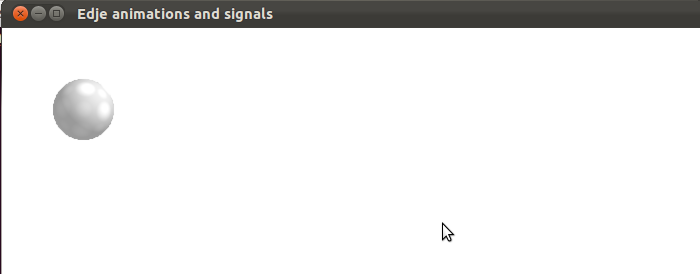In this example we will make an animation of a bouncing ball.
Our focus now will be in the .edc file, because in the C source code we just load the edje object and do nothing else.
We want to give the freedom to the object to use the whole canvas of our program, so lets define the min, max of our group:
At the description block bellow we are saying that this part has an image, defining the max and min size and it's position on the edje_object. The default state is the first state of the part, this means that when the edje object is loaded this one is going to be showed to you.
Now in the next description block we are saying where the ball is going to stop. Note that we have the "inherit" property. This means we are inheriting everything from default, except rel1 and rel2, because we are redefining it.
We defined how our object will look like and it's position during the animation, now we need to define how it's going to act during the time. To do this we will use the programs block
The first program block will start the animation, it will wait for the 'load' signal. This signal is generated when the edje object is loaded. The 'after' property is saying to this program block exactly this: "When you finish, call the program 'animation,state1' ". The 'in' property is saying, wait 0.5 seconds until you execute this program block.
Now lets make the ball move and bounce it. In the second program block we are defining what we need to do with the action property. So we are saying change to the state "down-state" using the transition BOUNCE and apply this to the part "part_bubble". You can notice that BOUNCE has three parameters, the first one is saying how much time the transition will last, the second one is the factor of curviness and the last one is saying how many times and object will bounce.
#ifdef HAVE_CONFIG_H
#include "config.h"
#else
#define PACKAGE_EXAMPLES_DIR "."
#define EINA_UNUSED
#endif
#ifndef PACKAGE_DATA_DIR
#define PACKAGE_DATA_DIR "."
#endif
#include <Ecore.h>
#include <stdio.h>
#define WIDTH (700)
#define HEIGHT (700)
static void
{
}
int
{
const char *edje_file = PACKAGE_DATA_DIR"/animations2.edj";
Evas *evas;
Ecore_Evas *ee;
Evas_Object *edje_obj;
Evas_Object *bg;
if (!ee) goto shutdown_edje;
fprintf(stderr, "loading edje file; %s\n", edje_file);
{
fprintf(stderr, "Could not load the edje file - reason:%s\n", errmsg);
goto shutdown_edje;
}
return EXIT_SUCCESS;
return EXIT_FAILURE;
}
Edje Graphical Design Library.
EAPI int ecore_evas_init(void)
Inits the Ecore_Evas system.
Definition ecore_evas.c:608
EAPI void ecore_evas_title_set(Ecore_Evas *ee, const char *t)
Sets the title of an Ecore_Evas' window.
Definition ecore_evas.c:1541
EAPI void ecore_evas_callback_delete_request_set(Ecore_Evas *ee, Ecore_Evas_Event_Cb func)
Sets a callback for Ecore_Evas delete request events.
Definition ecore_evas.c:1190
EAPI void ecore_evas_show(Ecore_Evas *ee)
Shows an Ecore_Evas' window.
Definition ecore_evas.c:1494
EAPI Evas * ecore_evas_get(const Ecore_Evas *ee)
Gets an Ecore_Evas's Evas.
Definition ecore_evas.c:1314
EAPI Ecore_Evas * ecore_evas_new(const char *engine_name, int x, int y, int w, int h, const char *extra_options)
Creates a new Ecore_Evas based on engine name and common parameters.
Definition ecore_evas.c:1053
EAPI int ecore_evas_shutdown(void)
Shuts down the Ecore_Evas system.
Definition ecore_evas.c:672
EAPI Eina_Bool ecore_evas_object_associate(Ecore_Evas *ee, Evas_Object *obj, Ecore_Evas_Object_Associate_Flags flags)
Associates the given object to this ecore evas.
Definition ecore_evas_util.c:223
EAPI void ecore_evas_free(Ecore_Evas *ee)
Frees an Ecore_Evas.
Definition ecore_evas.c:1097
void ecore_main_loop_quit(void)
Quits the main loop once all the events currently on the queue have been processed.
Definition ecore_main.c:1321
void ecore_main_loop_begin(void)
Runs the application main loop.
Definition ecore_main.c:1311
int edje_shutdown(void)
Shuts down the Edje library.
Definition edje_main.c:262
int edje_init(void)
Initializes the Edje library.
Definition edje_main.c:35
Edje_Load_Error edje_object_load_error_get(const Eo *obj)
Gets the (last) file loading error for a given Edje object.
Definition edje_legacy.c:15
Evas_Object * edje_object_add(Evas *evas)
Instantiates a new Edje object.
Definition edje_smart.c:22
const char * edje_load_error_str(Edje_Load_Error error)
Converts the given Edje file load error code into a string describing it in English.
Definition edje_load.c:108
Eina_Bool edje_object_file_set(Evas_Object *obj, const char *file, const char *group)
Sets the EDJ file (and group within it) to load an Edje object's contents from.
Definition edje_smart.c:467
#define EINA_TRUE
boolean value TRUE (numerical value 1)
Definition eina_types.h:539
#define EINA_UNUSED
Used to indicate that a function parameter is purposely unused.
Definition eina_types.h:339
EVAS_API void evas_object_show(Evas_Object *eo_obj)
Makes the given Evas object visible.
Definition evas_object_main.c:1814
EVAS_API void evas_object_color_set(Evas_Object *obj, int r, int g, int b, int a)
Sets the general/main color of the given Evas object to the given one.
Definition evas_object_main.c:2024
EVAS_API void evas_object_move(Evas_Object *obj, Evas_Coord x, Evas_Coord y)
Move the given Evas object to the given location inside its canvas' viewport.
Definition evas_object_main.c:1171
EVAS_API void evas_object_focus_set(Efl_Canvas_Object *obj, Eina_Bool focus)
Indicates that this object is the keyboard event receiver on its canvas.
Definition efl_canvas_object_eo.legacy.c:39
EVAS_API void evas_object_resize(Evas_Object *obj, Evas_Coord w, Evas_Coord h)
Changes the size of the given Evas object.
Definition evas_object_main.c:1236
EVAS_API Evas_Object * evas_object_rectangle_add(Evas *e)
Adds a rectangle to the given evas.
Definition evas_object_rectangle.c:78
